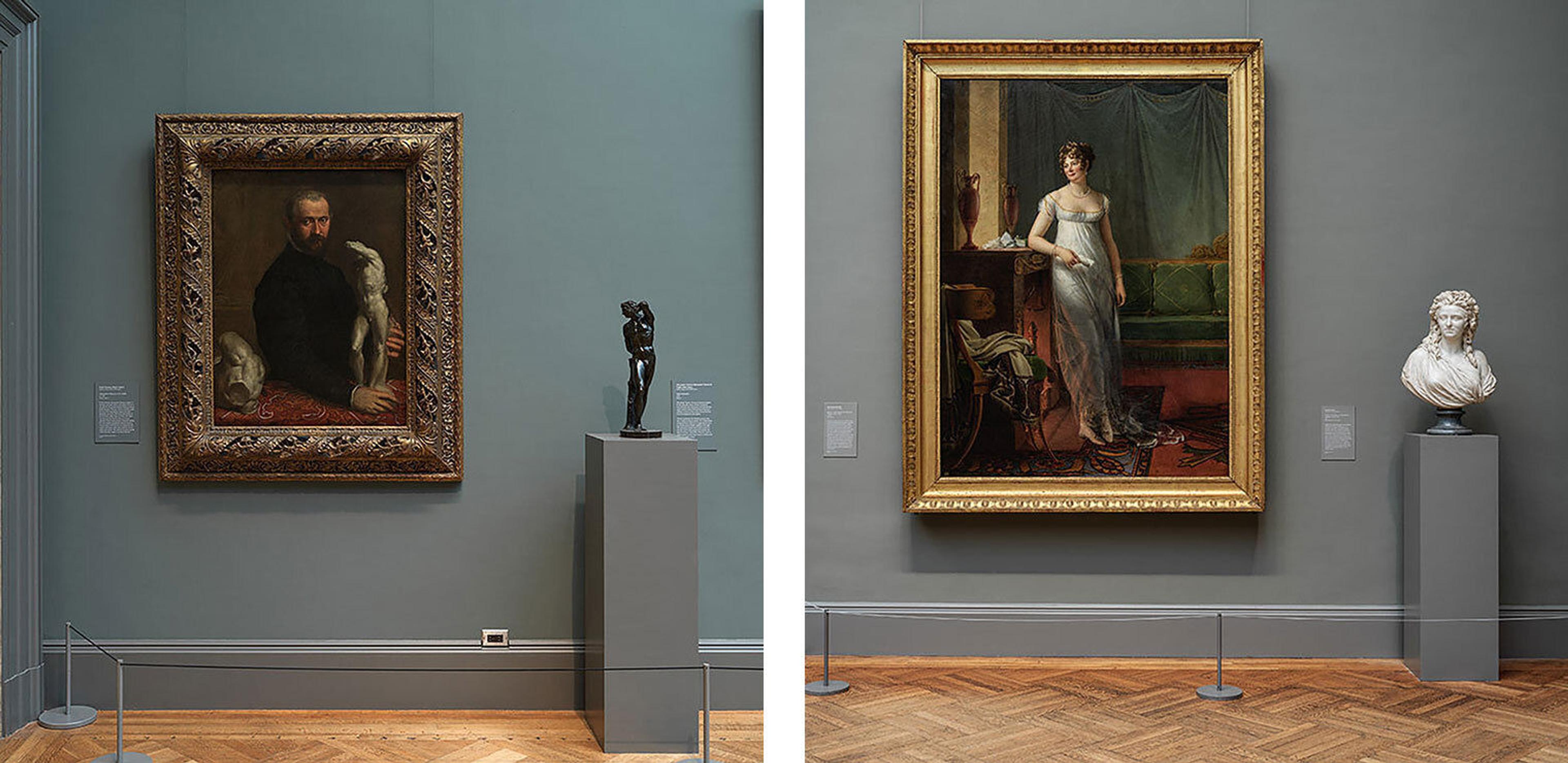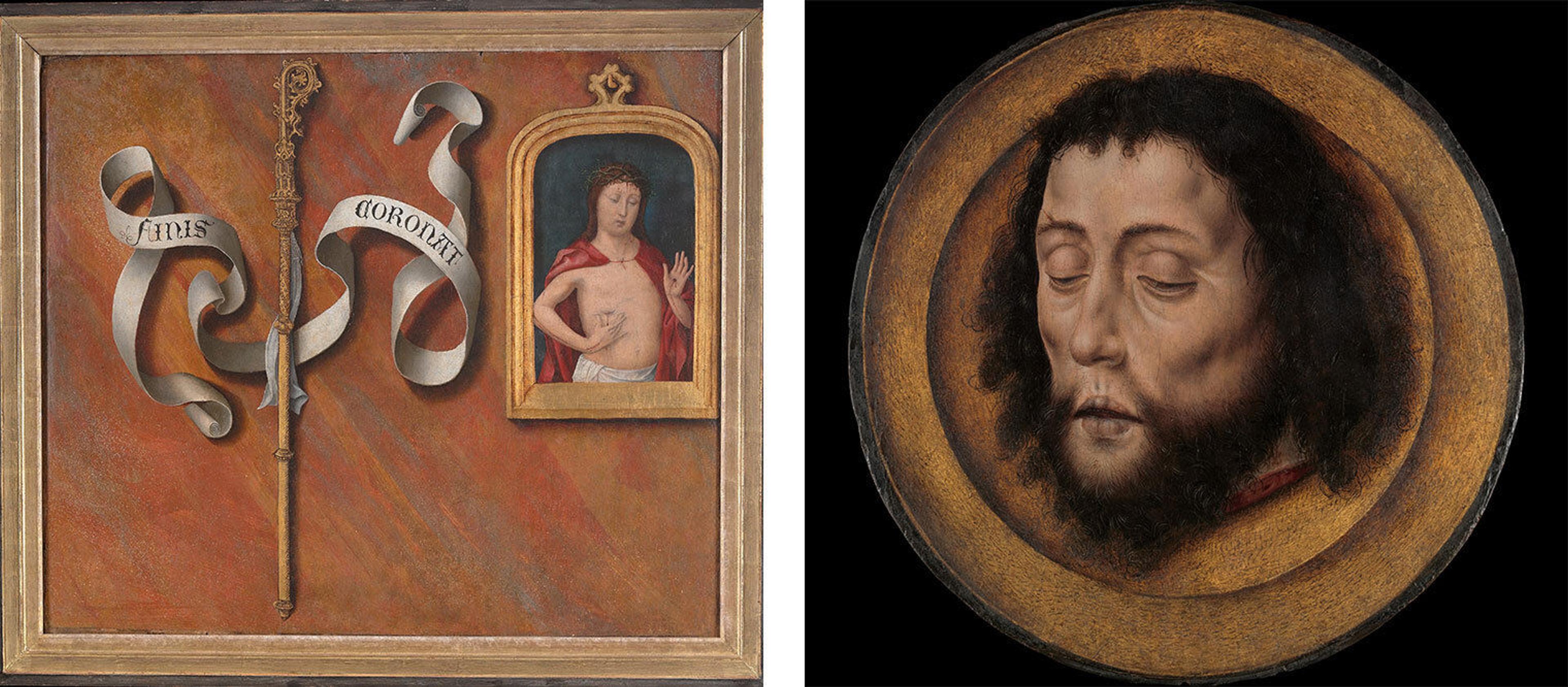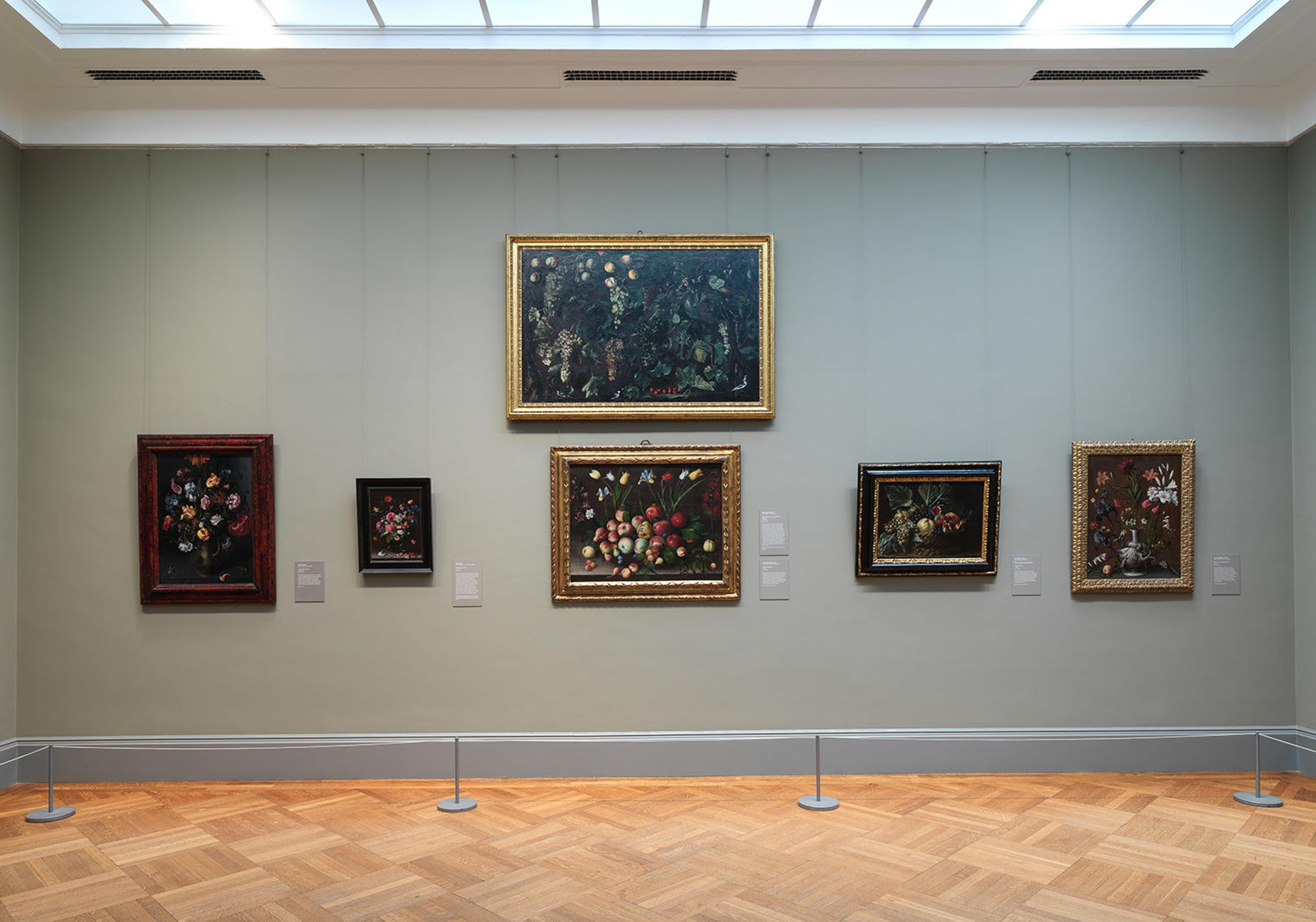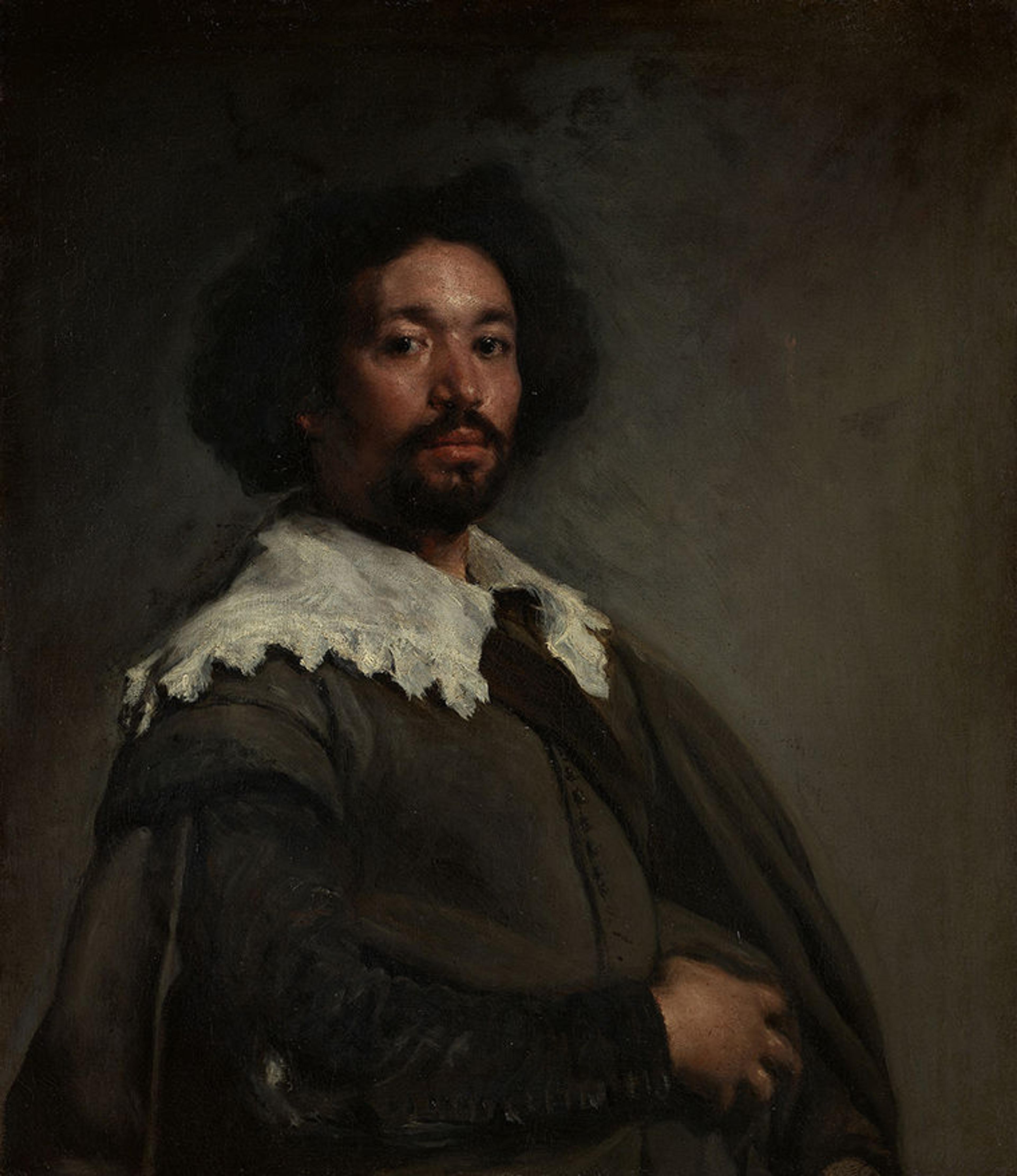In 2018 The Met began the monumental task of replacing the skylights over the galleries containing its famous collection of Old Master paintings. We are now halfway through the project and in the twenty-one refurbished galleries have installed works of stellar quality in ways that we hope will encourage visitors to experience them, quite literally, in a new light.
We have introduced sculpture and ceramics to encourage dialogues across mediums. We have created thematic galleries combining works from different countries to bring out shared concerns or underscore differences—in effect treating Europe not as a fixed map of political borders but a constantly shifting network of exchange. We have also highlighted various works that have the potential to complicate, contradict, and even subvert conventional narratives. In short, building on the collection’s great landmarks that traditionally define the trajectory of European painting, from Giotto di Bondone to Francisco Goya, we have tried to bring out the complexities, conflicts, and contradictions that accompanied the rise of Europe as the dominant, disruptive power in the world.
A New Look at Old Masters is a temporary installation. In summer 2022 we anticipate reinstalling the whole collection throughout all forty-four refurbished and relit galleries. For the time being, the exhibition of Dutch artworks, In Praise of Painting, remains on view in the Lehman Wing, as does the Museum’s extraordinary collection of paintings by El Greco and a significant number of early Italian paintings.
Integrating sculpture and painting has allowed us to underscore shared goals, whether the emulation of classical models, the creation of textural variation (by color in painting; by surface treatment in sculpture), or crucially, psychological characterization. The presence of medals and ceramics poses questions relating to the traditional hierarchy of the arts. By highlighting broad themes such as portraiture, landscape, and history painting, we have introduced conversations among some of the Museum’s most celebrated works, normally seen in separate galleries. In the gallery devoted to seventeenth-century portraiture, Peter Paul Rubens’s family portrait (circa 1635) hangs opposite Charles Le Brun’s depiction of the German banker Everard Jabach and his family (circa 1660), one a personal ode to love, the other a construction of social prominence as witnessed by the artist, who has shown himself reflected in a mirror. Velázquez’s depiction of his enslaved assistant Juan de Pareja and Andrea Sacchi’s full-length portrait of the castrato singer Marc’antonio Pasqualini reverse the association of portraiture with privilege.

Johann Liss (German, 1595/1600–1631). The Temptation of Saint Mary Magdalen, ca. 1626. Oil on canvas, 38 7/8 x 49 1/2 in. (98.8 x 125.8 cm). The Metropolitan Museum of Art, New York, Purchase, Walter and Leonore Annenberg Acquisitions Endowment Fund; Gifts of Irma N. Straus and Lionel F. Straus Jr., in memory of his parents, and Bequests of Milena Jurzykowski and Theodore M. Davis, by exchange; Gwynne Andrews and Victor Wilbour Memorial Funds; Charles and Jessie Price Gift, and funds from various donors, 2020 (2020.220)
Gallery 621, devoted to history painting, finds masterworks by two painters whose work laid the basis for two contrasting styles: Peter Paul Rubens and Nicholas Poussin, as well as The Met’s extraordinary new acquisition, Johann Liss’s Temptation of Mary Magdalen (circa 1626). A German artist, Liss was attuned to Rubens and Poussin but also looked with profit at the young Gian Lorenzo Bernini’s sculptures. In the center of the gallery is a fascinating statue from the Department of Greek and Roman Art that’s only partly ancient. It is a creative seventeenth-century reimagining of Bacchus seated on a leopard by the Franco-Flemish sculptor François Duquesnoy, who, like his good friend Poussin, was an ardent student of classical sculpture.
In other galleries we underscore the contributions of women artists and, very importantly, the presence of African people in Europe, whether ennobled as one of the three kings adoring the infant Christ or as the enslaved servant of an aristocratic woman returning from the colonies—works that call attention to issues of racism, colonialism, and imperialism.
Dialogues with scripture

View of Gallery 614.
Framed, two-dimensional pictures create windows onto vibrant worlds and invite viewers to imagine entering them. Sculptures, on the other hand, share our physical space and inspire us to see them from multiple points of view. Sculptures invite us to participate by engaging our eyes, body, and mind. And when sculptures are displayed in a picture gallery, this way of seeing enriches our encounters with paintings and fosters dialogue between these sister arts.
Encountering Jean Guillaumet’s limestone sculpture The Virgin Annunciate (circa 1510–20) near Hans Memling’s painting of The Annunciation (1480–89) in Gallery 603 lends Memling’s Virgin and Angel startling substance and physicality. The divine figures seem to transgress their sacred pictorial confinement and enter into our worldly realm.

Left: View of Veronese's portrait of Alessandro Vittoria next to Vittoria's bronze sculpture. Right: View of Pajou’s marble bust of Madame Lavoisier. ;Jacques-Louis David’s painting of Madame Lavoisier is on an adjacent wall.
Interactions between paintings and sculptures also afford insight into artists’ creative minds. Veronese’s compelling portrait of Alessandro Vittoria (circa 1580) depicts the sculptor holding a plaster model for his Saint Sebastian (1566). Next to the superbly finished bronze, we witness Vittoria’s transformation of his sculptural idea into sublime reality. The painter Jacques-Louis David captures Madame Lavoisier (1788) gloriously bathed in pellucid light. How different is Pajou’s marble bust of Lavoisier’s contemporary, Madame de Wailly (1789)!
Neoclassical painting represents the world as fixed. David renders light as immutable, whereas Pajou’s bust is animated through the gallery’s changing natural light. The ephemeral effects of daylight enliven the polished marble skin, and her portrait is imbued with an illusory, evanescent breath of life that makes the tender gestures between the Lavoisiers more resonant and fleeting.
— Denise Allen and Elyse Nelson
Between “real” and “painted”

View of Gallery 624 with Giovanni di Paolo's altarpiece in the center.
The central elements of an altarpiece by the fifteenth-century Sienese painter Giovanni di Paolo anchor one wall in Gallery 624, devoted to gold-ground painting. The Met’s remarkable collection of this beloved artist’s work (on view in the Lehman Collection) spans the breadth of his career and includes small devotional images, animated narrative scenes, and larger panels that were once part of imposing altarpieces.
While we don’t know the church for which this altarpiece was made, the central panel is dated 1454. The intense materiality of these panels, with their punched gold decoration and tooled surfaces, links them to the earliest pictures exhibited in the gallery, made over a century and a half earlier, at the chronological beginning of the Museum’s collection of European paintings. Artists of these earlier paintings were influenced by Byzantine icons, but they also responded to elaborately worked tabernacles and reliquaries made of precious gold and silver, and encrusted with highly venerated precious and semiprecious stones. Their intrinsic materiality is underscored by the tension between the “real” and the “painted” stimulated stone on the back of Pietro Lorenzetti’s Crucifixion (1340s).
The gold used on these paintings was likely sourced from either Africa or central Europe; Italy did not have substantial sources of its own. The vibrant blue in most of the panels was made from lazurite (lapis lazuli) mined in the ancient quarries of Badakhshan, in what is now northeastern Afghanistan. When heated, the alchemical marriage of mercury and sulphur creates a blackened crust that, after being finely ground, produces the bold red vermillion that resonates in these paintings.
Giovanni di Paolo anchors his figures on a green marble dais. He signed the altarpiece on the face of the stone under the enthroned Virgin, at the threshold of the picture plane, between the viewer and the world of the holy figures under the gilded arcade.
Fooling the eye (trompe l’oeil)

Left: Aelbert Bouts (Netherlandish, ca. 1451/54–1549). Head of Saint John the Baptist on a Charger, ca. 1500. Oil on poplar, Diameter 11 1/8 in. (28.3 cm). The Metropolitan Museum of Art, New York, Bequest of Rupert L. Joseph, 1959. Right: Bernard van Orley, (Netherlandish, ca. 1492–1541/42). The Birth and Naming of Saint John the Baptist; (reverse) Trompe-l'oeil with Painting of The Man of Sorrows, ca. 1514–15. Oil on wood, 25 x 30 in. (63.5 x 76.2 cm). The Metropolitan Museum of Art, New York, Bequest of Hertha Katz, 2000, (2001.216.3)
The ability of painters to create the impression of a three-dimensional object on a two-dimensional surface, thereby deceiving the eye, goes back to Greek and Roman times. A dazzling array of illusionistic effects adorned the walls of ancient villas, famously at Pompeii and Boscoreale (as in The Met’s Cubiculum). During the Renaissance, the development of perspective schemes in paintings also encouraged a revival of trompe l’oeil as another strategy to engage viewers. In Galleries 602 and 624, the Portrait of a Carthusian by Petrus Christus (1446) and the Madonna and Child (circa 1480) by Carlo Crivelli tease us with a painted fly on the fictive frame or parapet. Is it in or on the picture?
In Gallery 606, the installation that shows the reverse side of Bernard van Orley’s Birth and Naming of Saint John the Baptist (circa 1514–15) near Albrecht Bouts’s Head of Saint John the Baptist on a Charger (circa 1500) recognizes different objectives. The former—showing a banderole with the motto FINIS CORONAT meandering beneath an abbot’s crozier, adjacent to a framed painting of Christ—advertises the devotion and elevated professional status in the Catholic Church of Jacques Coëne, who commissioned the work. By contrast, Bouts’s gruesome Saint John head, seemingly just severed from his body and placed on a golden platter, solicits the viewer to empathize with the martyr’s inspirational story of constant faith and consequential sacrifice. Such paintings were propped up on church altars, inviting followers of the cult of Saint John to kneel in fervent prayer before the affecting image.
These trompe l’oeil works are but a prelude to the developing genre of still life paintings in Gallery 627 that record in astonishing detail the natural world of fruits, flowers, and objects of virtue.
Women painters and still life painting

View of Gallery 627.
In 2020, The Met acquired A Bouquet of Flowers (circa 1616) by Clara Peeters, a woman painter and founding figure in the history of still life. Serendipitously, in the same year, Errol M. Rudman bequeathed eleven seventeenth-century Italian paintings to the Museum, including three canvases by Orsola Maddalena Caccia, whose remarkable story as a painter-nun we had never dreamt of being able to tell in such depth.
Caccia’s works are exceedingly rare because the vast majority remain in her native city, Montcalvo, Italy, where she painted to support a convent founded by her father. Her most characteristic works, such as Flowers in a Grotesque Vase (circa 1635), reveal an idiosyncratic approach to still life that feels surprisingly contemporary, even graphic in design, governed by a taste for symmetry, individuation, and a shallow depth of field. Fluent in the language of flowers, she assembled floral rebuses within such paintings that must have been intended to guide spiritual exercises and meditation.
The arrival of works by Peeters and Caccia has inspired a wall devoted to still life painting in Gallery 627. They are joined by two works, including another Rudman gift, by Bartolomeo Cavarozzi, whose approach to still life developed out of the natural sciences, another important thread in the European still life tradition. In the same gallery, visitors can also find one of the earliest known independent still lifes in European art, painted by Antonio Leonelli, and the first independent vanitas subject, painted by Jacques de Gheyn II.
— David Pullins
British painting and conversation pieces

Francis Wheatley (British, 1747–1801). The Saithwaite Family, ca. 1785. Oil on canvas, 38 3/4 x 50 in. (98.4 x 127 cm). The Metropolitan Museum of Art, New York, Gift of Mrs. Charles Wrightsman, 2009, (2009.357)
Some of our new galleries tell an in-depth story about a single national school, such as the gallery dedicated to eighteenth-century British painting. Gallery 615 emphasizes the expansion of portraiture during this period, showing the likenesses not only of aristocrats, but also a famous boxer and an actress with a rather scandalous personal life (1790). In late eighteenth-century London, portraits catered to a new appetite for celebrity culture and filled prominent public exhibition spaces like the Royal Academy (founded in 1768).
One of the most distinctive innovations of eighteenth-century British art is the so-called conversation piece. Loosely defined as a small-scale group portrait, conversation pieces convey values of intimacy, refinement, and social life. Among The Met’s great conversation pieces is a foundational example by William Hogarth, depicting the wedding of two fashionable young Londoners (1729). As Hogarth’s painting reveals, conversation pieces make for compelling social documents at the same time as they deploy all the resources of art to heighten the refinement of their subjects (in this case, setting the wedding in a much grander church than the real-life venue!).
My personal favorite among our conversation pieces is Francis Wheatley’s portrait of the Saithwaite family (circa 1785). Here, the central female figure appears to greet the viewer of the portrait, flanked by her husband and daughter in a relaxed configuration of family intimacy. At the same time, the artist’s careful description of an elegant interior evokes a whole world of long-lost domesticity that feels a bit like stepping into a time machine.
The Black presence in early modern Europe

Left: Nicolas de Largillierre (or Largillière) (French, 1656–1746). Portrait of a Woman and an Enslaved Servant, 1696. Oil on canvas, 55 x 42 in. (139.7 x 106.7 cm). The Metropolitan Museum of Art, New York, Rogers Fund, 1903, (03.37.2). Right: Velázquez (Diego Rodríguez de Silva y Velázquez) (Spanish, 1599–1660). Juan de Pareja (1606–1670), 1650. Oil on canvas, 32 x 27 1/2 in. (81.3 x 69.9 cm). The Metropolitan Museum of Art, New York, Purchase, Fletcher and Rogers Funds, and Bequest of Miss Adelaide Milton de Groot (1876–1967), by exchange, supplemented by gifts from friends of the Museum, 1971 (1971.86)
It is riveting, and profoundly disturbing, to observe the precision with which Nicolas de Largillière’s Portrait of a Woman and an Enslaved Servant (1696) aestheticizes the ideologies of white supremacy then being formulated in French state academies. This racialized subordination—represented most overtly here by the gleam of the servant’s hinged slave collar—is underscored by the young boy and the dog he carries, conjuring a ruling-class fantasy of fidelity, and by his balance in the picture with the exotic parrot. The youth’s gaze upward locks in the painting’s racial hierarchy. The woman poses a studied aristocracy, captured in myriad details, such as her haughtily turned hand. Viewers may recoil at her opulence once they’re aware of the sadistic violence that persons of her station presided over at their slaveholding properties in colonized territories.
This portrait occupies one side of a triangular subgroup within the Baroque Portraiture Gallery (617) that captures the pervasive ties to empire and enslavement among the period’s European elites. It is a counterpoint to Philippe de Champaigne’s Jean-Baptiste Colbert (1655), which presents its subject with a learned dignity that masks his implication with these issues. Colbert, who later became Louis XIV’s minister of finance, enabled the founding of the venerated Academie Royale yet was the author of the Code Noir, which legally sanctioned the violent repression enforced by slaveholders.
Both paintings contextualize Velázquez’s celebrated portrait of Juan de Pareja, seen on an adjacent wall. This ennobling depiction of the Spanish artist’s enslaved assistant, shown shortly before he was emancipated and became an artist in his own right, captures one possible outcome within Europe’s early systems of enslavement. Pareja transcended a childhood that may have looked like that of Largillière’s unnamed servant.
Pareja’s successful artistic career highlights an important absence in these galleries that we seek to reverse in the coming installations. The Met’s collection includes symbolic Black figures, such as the resplendent young African king featured in numerous Renaissance Adorations of the Magi, and Cranach’s heroic portrayal of the martyred Saint Maurice. We still lack depictions of Black Europeans who occupied varied social roles including sailors, musicians, actors, priests, soldiers, diplomats, and members of skilled craft guilds. As holdings expand to include such representations, we can more accurately reflect the full extent of the Black presence in early modern Europe.
— Denise Murrell
